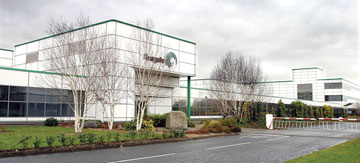SEMICONDUCTOR & ELECTRONICS

Sparks Fly:
New Technology Powers Electronics Industry Growth
New Technology Powers Electronics Industry Growth
 |
| A US$47-million incentive package from Invest Northern Ireland helped cinch Seagate Technologies' decision to expand at facilities in Springtown (pictured) and Limavady, says John Spangler, Seagate vice president and director of the Springtown complex. |
| S |
ilicon wafers that hold a whole lot more chips are hot.
Flat screens are hot.
Digital cameras are over.
It's not that digital cameras aren't going to dominate the amateur photography market – it's that they already have. Demand, which grew rapidly in the last five years, has tableaued and capacity has already expanded to meet demand. Now, the world is smack in the middle of the digital TV revolution. Major producers like Korea's LG Electronics and Royal Philips Electronics of the Netherlands are adding capacity as fast as they can.
Leading-edge semiconductor fabricators are smiling today too. Voracious appetites for the latest generation technology – a 12-inch, 300-mm. wafer that holds 200 percent more chips – are inhaling product as fast as it emerges from clean rooms around the world. These new wafers power NAND memory – in iPods, in flash drives, in multitasking cell phones. Industry analysts estimate that the market for NAND flash memory products will grow by 40 percent in 2006, to reach US$14.8 billion in global revenue. In fact, it's a whole new growth landscape for fabs once worried about excess capacity.
Fabs Expanding Everywhere
A quick look suggests that location trends aren't all that clear cut for this sector of the consumer electronics industry – even though revenue trends are. According to Gartner, the Asia/Pacific region, including China, Taiwan, Korea and Singapore, accounted for almost 45 percent of global semiconductor revenue in 2005.
But industry insiders say that, indeed, a pattern is emerging among high-end chip producers – sheltering in place.
"These companies are looking at where they are established, and building on established relationships," says Len Jelinek, director and senior semiconductor analyst at market research firm isuppli. "They are staying put. Intel already had a facility in Arizona and in Israel. AMD was already in Dresden. No one's pulling up stakes and going somewhere else entirely."

